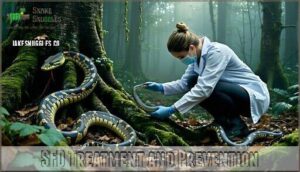This site is supported by our readers. We may earn a commission, at no cost to you, if you purchase through links.

You’ll recognize infected snakes by their facial swelling, cloudy eyes, and crusty skin lesions that can spread throughout their bodies.
The disease spreads through contaminated soil and can kill snakes within months if left untreated, making it a microscopic threat that spreads faster than a wildfire through snake communities.
While researchers are working on antifungal treatments, many wild populations continue declining as this silent killer operates, which could mean the difference between preserving these essential predators and watching entire species vanish from our ecosystems forever, highlighting the importance of understanding how this silent killer operates.
Table Of Contents
- Key Takeaways
- SFD Snake Disease Defined
- SFD Impact and Conservation
- Clinical Signs of SFD
- SFD Transmission and Diagnosis
- SFD Treatment and Prevention
- Frequently Asked Questions (FAQs)
- How to treat SFD in snakes?
- What is SFD snake disease?
- Can humans get snake fungal disease?
- What is the mortality rate for snake fungal disease?
- How to treat snake fungal disease?
- How do you treat fungal disease in snake plants?
- What are the clinical signs of snake fungal disease?
- How does SFD affect snake behavior?
- Is SFD contagious among different snake species?
- What are the economic implications of SFD?
- Conclusion
Key Takeaways
- You’ll recognize SFD by its distinctive symptoms – infected snakes develop facial swelling, cloudy eyes, crusty skin lesions, and behavioral changes like reduced activity and appetite loss.
- The disease spreads rapidly through contaminated soil – you can unknowingly transfer fungal spores between snake habitats on boots and equipment, making environmental transmission a major concern.
- Treatment options remain frustratingly limited – while antifungal medications like terbinafine and itraconazole show some promise, no proven cure exists and mortality rates reach 40-66% in affected populations.
- You can help prevent the spread through responsible wildlife practices – avoid handling wild snakes, clean equipment between uses, and support conservation efforts since SFD threatens essential ecosystem predators that control rodent populations.
SFD Snake Disease Defined
You’ve probably never heard of snake fungal disease, but it’s quietly devastating wild snake populations across North America.
This deadly infection, caused by the fungus Ophidiomyces ophiodiicola, was first identified in 2006 and has since spread to over 30 snake species.
Definition of Snake Fungal Disease
You can’t escape snake fungal disease once it takes hold.
This devastating fungal infection attacks wild snake populations across North America, causing severe health problems and death.
The disease spreads through contaminated environments, threatening wildlife conservation efforts.
Scientists identify this reptile fungal disease as a major concern for ophidian species survival and ecosystem balance.
Understanding the fungal infection causes is essential for developing effective prevention and treatment strategies to address this devastating fungal infection.
Ophidiomyces Ophiodiicola Fungus
You can’t escape the microscopic menace behind SFD snake fungal disease.
Ophidiomyces ophiodiicola represents a specialized pathogen that’s rewriting the rulebook on fungal biology and snake ecology.
This sneaky organism thrives in cool, moist conditions where snakes hibernate.
The disease mechanism involves the fungus penetrating snake skin through tiny wounds.
Understanding fungal genetics helps researchers develop better infection control strategies for ophidian fungal infection treatment protocols, which is crucial for combating snake fungal disease.
History of SFD Discovery
You can’t pinpoint exactly when sfd snake fungal disease first appeared because researchers only discovered this ophidian fungal infection in 2006.
The discovery process began when scientists noticed unusual snake fungus infection patterns in wild populations.
Research findings from that fungal origins investigation revealed SFD outbreaks had likely been occurring undetected for years before official documentation, which helped understand the fungal infection patterns.
SFD Impact and Conservation
You’ve likely heard that snakes face serious threats, but snake fungal disease represents one of the most devastating challenges to wild populations today.
This emerging pathogen doesn’t just kill individual snakes—it disrupts entire ecosystems where these predators play vital roles in controlling rodent populations and maintaining ecological balance.
Effects on Snake Populations
You’ll witness devastating population decline when SFD strikes snake communities.
New Hampshire’s timber rattlesnakes dropped over 50% in just one year following an outbreak. Lake Erie watersnakes fell 18% despite previous growth trends.
Illinois massasaugas faced such severe snake mortality that officials considered Endangered Species Act protection.
Conservation efforts now recognize SFD as a major threat alongside habitat loss. The disease’s environmental spread is a key factor in its transmission, often occurring through fungal disease sources, which is a significant environmental factor.
Role of Snakes in Ecosystems
You’ll find snakes serve as nature’s pest control specialists while maintaining ecosystem balance through their role in food chains.
These reptiles control rodent populations that would otherwise damage crops and spread disease.
Snake predation creates habitat diversity by influencing prey behavior patterns.
- Rodent Control: Snakes consume millions of agricultural pests annually, saving farmers billions in crop damage
- Food Web Stability: They connect different trophic levels through species interactions as both predator and prey
- Disease Prevention: By controlling rodent populations, snakes reduce transmission of diseases like Lyme disease and hantavirus
Unfortunately, fungal disease in snakes disrupts these critical ecosystem services.
When snake fungal infection treatment isn’t available in wild populations, entire food webs suffer imbalances.
Threats to Snake Species
Beyond human persecution, snake species face mounting environmental pressures.
Habitat destruction fragments populations, leaving them vulnerable to fungal disease in snakes.
Climate change alters ecosystems, while environmental pollution weakens immune systems.
Snake poaching targets rare species for illegal trade.
Human activities introduce pathogens, worsening snake fungal infection treatment challenges.
These combined threats create perfect conditions for reptile fungal infections to spread rapidly.
The spread of snake fungal disease is often attributed to fungal pathogen introductions through human activities, leading to snake fungal infection and reptile fungal infections.
Human Persecution and Habitat Loss
You’re not just fighting disease when snakes face extinction – human persecution and habitat destruction create the perfect storm.
When you clear forests or kill snakes out of fear, you’re disrupting ecosystems that depend on these predators.
Human impact through development fragments snake populations, making wildlife conservation efforts more difficult.
Ecosystem disruption weakens snakes’ immune systems, leaving them vulnerable to fungal infection in reptiles and other reptile health issues, which is a result of human persecution and habitat destruction.
Clinical Signs of SFD
You’ll notice several warning signs when SFD strikes wild snakes in your area.
The disease causes facial swelling, eye infections, pneumonia, and distinctive skin nodules that can lead to death within months if left untreated, which is a critical aspect of SFD.
Facial Swelling and Eye Infections
Snake fungal disease symptoms become unmistakable when you spot the telltale facial deformity and eye lesions.
You’ll notice severe swelling around infected snakes’ heads, often accompanied by skin ulcers that create grotesque facial distortions.
Eye infections frequently cause blindness, while infection control remains challenging in wild populations.
Swelling management isn’t possible without professional snake fungal disease treatment interventions targeting these fungal disease symptoms.
Understanding the fungal disease causes is essential for developing effective treatment and prevention strategies to address the fungal disease.
Pneumonia and Skin Nodules
You’ll recognize respiratory issues and nodule formation as serious snake disease symptoms when fungal pneumonia develops.
Skin lesions appear as raised bumps containing infected tissue that spreads throughout the body.
- Respiratory distress – Snakes struggle to breathe as fungal infection attacks lung tissue
- Raised skin nodules – Hard bumps form under scales containing fungal organisms
- Open wound development – Nodules rupture creating secondary bacterial infections
- Widespread lesion patterns – Multiple nodules appear across the snake’s body surface
- Progressive tissue damage – Fungal infection destroys healthy skin and muscle tissue
Incubation Period and Mortality Rate
Time reveals SFD’s deadly timeline through distinct phases.
You’ll notice snake disease symptoms emerging within 30-37 days after exposure, though some cases show fungal infection in reptiles as early as 12 days.
Disease progression varies substantially based on environmental conditions and species.
| Timeline Stage | Key Details |
|---|---|
| Early Exposure | 4-12 days: Initial infection timeline begins |
| Visible Symptoms | 2-5 weeks: Snake health problems become apparent |
| Clinical Signs | 15-20 days: Severe lesions develop rapidly |
| Mortality Risk | 40-66% fatality rate depending on setting |
Survival odds differ dramatically between wild and captive populations.
Laboratory studies show 40% mortality rates, while captive snakes face 66% fatality rates.
Wild populations experience lower observed mortality at 9.8%, though field data collection challenges may underestimate true impact.
Fungal growth rate accelerates under stress, making early detection vital for snake fungus prevention.
Understanding these mortality factors helps researchers develop better treatment protocols.
Systemic Infections and Organ Damage
When SFD advances beyond surface symptoms, you’ll witness devastating systemic infections and organ damage that can kill infected snakes within months.
The fungus spreads through bloodstream circulation, targeting essential organs and triggering severe immune responses that often prove fatal.
Critical organ damage patterns include:
- Liver necrosis – Dark, mushy tissue breakdown that stops toxin processing
- Kidney failure – Swollen organs that can’t filter waste from blood
- Lung inflammation – Thick, yellowish fluid that blocks oxygen exchange
Fungal toxins overwhelm the snake’s immune response, causing widespread tissue damage.
Without proper infection control and fungal infection treatment, reptile fungal infection treatment becomes nearly impossible.
These sfd symptoms represent the disease’s most dangerous phase, where even aggressive treatment rarely saves affected snakes from organ failure.
SFD Transmission and Diagnosis
You can’t always see how SFD spreads between snakes, but contaminated soil plays a major role in transmission.
Scientists use skin biopsies and DNA testing to confirm infections since the fungus doesn’t always show obvious symptoms right away.
Contaminated Soil and Human Tracking
You unknowingly become a human vector when contaminated soil clings to your boots and equipment.
This soil pollution spreads fungal spores between snake habitats, creating new infection hotspots.
Tracking methods show humans transfer viable conidia through footwear and tools, making reptile fungal infection treatment more challenging as fungal spread accelerates across previously unaffected areas.
Fungal Growth and Temperature
During cool temperatures, fungal spores thrive in specific growth patterns that make ideal growth occurring at 25°C (77°F) while most isolates fail at 35°C (95°F).
Temperature control affects fungal ecology substantially. You’ll find thermal limits create dangerous conditions for reptile disease symptoms.
Snake disease prevention requires understanding how fungal disease impacts snake health issues when environmental conditions favor pathogen survival, which is crucial for reptile disease prevention.
Laboratory Confirmation and Skin Biopsy
When diagnosing snake disease prevention concerns, veterinarians need Lab Diagnosis through careful Tissue Analysis.
You’ll find that Skin Lesions undergo Biopsy Results examination, where specialists collect samples from affected areas.
This Fungal Testing process helps identify reptile disease symptoms accurately.
Through skin biopsy procedures, labs can confirm snake health issues and detect fungal disease in reptiles effectively.
Histopathological Examination and DNA Detection
Microscopic analysis reveals the disease’s fingerprint through detailed tissue examination.
Laboratory experts use specialized techniques to confirm fungal infections in reptiles:
- Tissue Sampling – Collect skin samples from affected areas
- Microscopic Analysis – Examine cells under high magnification
- Molecular Testing – Extract and amplify fungal DNA sequences
- Genetic Sequencing – Identify specific Ophidiomyces ophiodiicola markers
- DNA Detection – Confirm presence through advanced laboratory methods
These histopathological examination techniques provide educational resources for understanding student life impacts on wild snake populations.
SFD Treatment and Prevention
You’ll face significant challenges when treating SFD since no proven cure exists for wild snakes.
Current antifungal treatments show limited success and researchers continue working to develop better prevention methods through responsible wildlife management, which is crucial for wildlife.
Current Treatment Options and Limitations
Once you’ve confirmed SFD through laboratory testing, you’ll find treatment options remain frustratingly limited. Current antifungal therapy shows mixed treatment outcomes, with many medications lacking consistent efficacy against this stubborn disease.
Fungal resistance complicates medication efficacy, making disease management challenging for wildlife professionals. You can’t simply apply standard treatments – SFD demands specialized approaches that often fall short of expectations.
Effective disease management strategies are essential to improve treatment outcomes and prevent further spread of the disease, which is a critical requirement for wildlife professionals to manage SFD effectively.
Antifungal Medications and Efficacy
Veterinarians use terbinafine and itraconazole as primary antifungal therapy for snake fungal disease.
However, medication efficacy varies substantially between species, with some showing concerning fungal resistance patterns.
Treatment outcomes depend heavily on early diagnosis and proper drug interactions management.
You’ll need specialized resources and educational initiatives from experienced reptile veterinarians, as school administration of these medications requires extensive student support and community engagement protocols.
The treatment often involves understanding Terbinafine medication options to effectively combat the disease.
Development of New Treatments and Preventives
Researchers are racing to develop breakthrough treatments that could save snake populations worldwide.
Fungal research focuses on novel antifungal therapy delivery methods like nebulization and topical sprays. Vaccine development remains a priority, though no effective immunization exists yet.
Treatment options include engineered probiotics and beneficial skin microbes.
Preventive measures involve educational initiatives and community engagement supporting student development through academic resources and enhanced student support programs.
The development of effective SFD treatments relies on understanding antifungal medications, which is a crucial aspect of saving snake populations through novel antifungal therapy and effective immunization methods, ultimately leading to successful treatment options and better preventive measures.
Importance of Responsible Snake Handling
You can’t fight what you can’t see coming. Preventing Snake Fungal Disease starts with smart snake safety practices that protect both wildlife and people.
Educational programs teach students proper wildlife conservation techniques.
Here’s your action plan:
- Never handle wild snakes – Leave venomous species and unknown snakes alone
- Follow school policies – Use student resources for safe snake encounters
- Practice responsible handling – Clean equipment between uses to prevent spread
Smart handling tips save snake populations from this deadly fungal threat. Using proper snake handling gear is essential for safety and prevention.
Frequently Asked Questions (FAQs)
How to treat SFD in snakes?
Looking for snake fungal disease treatment without proper veterinary care is like trying to fix a broken bone with band-aids.
You’ll need antifungal medications like itraconazole or voriconazole from a reptile veterinarian.
Plus improved husbandry conditions including proper temperature and humidity control, which are crucial for effective treatment and recovery from snake fungal disease.
What is SFD snake disease?
Snake Fungal Disease (SFD) is a skin infection that affects wild snakes, causing lesions, scabs, and abnormal shedding. You’ll notice cloudy eyes, facial swelling, and behavioral changes in infected snakes.
Can humans get snake fungal disease?
No, you can’t catch snake fungal disease from infected snakes. This fungal infection affects only reptiles and amphibians, not mammals like humans. You’re safe handling infected snakes with proper precautions.
What is the mortality rate for snake fungal disease?
Experimental data reveals a striking 40% mortality rate among infected snakes.
You’ll find that infected snakes typically survive about 90 days after contracting the disease.
While severe cases can be fatal, many species show remarkable resilience.
How to treat snake fungal disease?
Treatment requires veterinary intervention with antifungal medications like itraconazole or voriconazole.
You’ll need to isolate affected snakes, improve habitat conditions, and follow prescribed medication protocols.
Supportive care includes proper temperature, humidity, and nutrition during recovery, which is crucial for the snake’s overall health, including the need for veterinary intervention.
How do you treat fungal disease in snake plants?
You’ll need to isolate your infected snake plant and remove affected leaves immediately.
Apply a fungicide spray designed for houseplants, improve air circulation, and reduce watering frequency to prevent future outbreaks.
What are the clinical signs of snake fungal disease?
Like shadows creeping across your snake’s skin, you’ll notice irregular patches of thickened, discolored scales that may appear crusty or ulcerated,
often accompanied by behavioral changes like increased hiding or reduced appetite.
How does SFD affect snake behavior?
You’ll notice infected snakes become sluggish and avoid basking, disrupting their normal temperature regulation.
They often hide more frequently, refuse food, and show decreased activity levels, making them vulnerable to predators.
Is SFD contagious among different snake species?
Yes, snake fungal disease spreads between different species.
Ophidiomyces ophidiicola affects numerous snake species, and infected snakes shed fungus into the environment where other snakes pick it up.
Environmental transmission makes cross-species infection common.
What are the economic implications of SFD?
Snake fungal disease absolutely devastates wildlife budgets nationwide. You’ll find that treating infected animals costs thousands per case, while population declines hurt eco-tourism revenue and require expensive habitat restoration efforts.
Conclusion
Looking at this fungal threat through a microscope reveals spores that look deceptively simple yet pack devastating power.
You’ve learned how SFD snake fungal disease silently spreads through contaminated soil, attacking everything from timber rattlesnakes to eastern racers.
While researchers develop new antifungal treatments, you can help by practicing responsible wildlife handling and supporting conservation efforts.
Early detection remains essential for treatment success.
Remember that protecting snake populations from this microscopic killer helps preserve the delicate balance of our ecosystems for future generations, which is crucial for maintaining ecosystems.
- https://www.nature.com/articles/s42003-024-06092-x
- https://www.gardenwildlifehealth.org/portfolio/snake-fungal-disease/
- https://www.usgs.gov/diseases-of-terrestrial-wildlife/snake-fungal-disease
- https://savethesnakes.org/2023/07/07/snake-fungal-disease-california/
- https://www.cwhc-rcsf.ca/docs/fact_sheets/SFD_FactSheet.pdf















